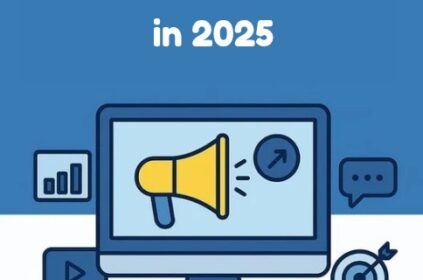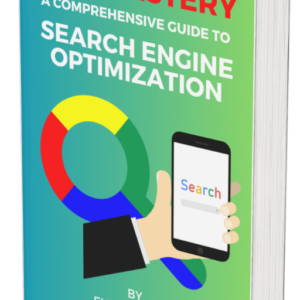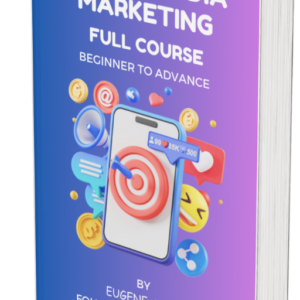Let me tell you about something that happened earlier this year at AdsTargets, Ad Network that serves as a bridge for online advertisers and publishers across the globe. We were working with one of our e-commerce clients who had a pretty common problem — a lot of potential customers were adding items to their carts but never completing the purchase. It’s frustrating, right? They were losing out on sales, and the numbers didn’t lie.
So, we decided to put a plan into action. We implemented a cart abandonment retargeting strategy along with dynamic product ads. These strategies are designed to show personalized ads to users who had shown interest in specific products but didn’t follow through. And guess what? Within just a few weeks, the results were impressive. The client saw a 40% increase in conversions and a 25% boost in revenue. All because we re-engaged those visitors with the right messages at the right time. It was a game-changer for their business.
That’s the power of retargeting — and it’s exactly what we’re going to discuss in this article today.
Retargeting is one of the most effective ways to bring back visitors who didn’t convert the first time and encourage them to complete their purchase. By strategically placing personalized ads across the web, you can boost your chances of closing the deal and turning those missed opportunities into revenue.
In this post, we will walk through the best retargeting strategies for e-commerce, from the basics to more advanced tactics that can really make a difference in your sales. So, if you’re ready to start seeing better results, let’s jump in!
What is Retargeting and Why It Matters for E-commerce
Retargeting, also known as remarketing, is a digital marketing strategy that involves displaying ads to users who have previously interacted with your website or mobile app but did not complete a desired action, such as making a purchase. This approach aims to re-engage potential customers and encourage them to return to your site to finalize their transactions.
Why Is Retargeting Important for E-commerce?
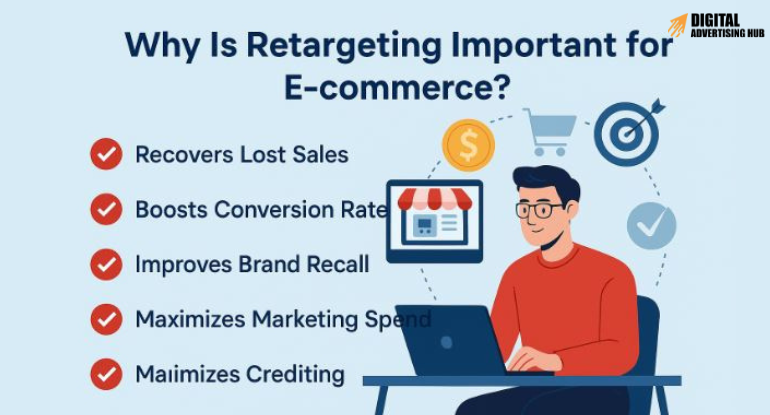
In the competitive world of e-commerce, converting visitors into customers is a significant challenge. The average e-commerce conversion rate globally is approximately 2.2% as of Q1 2023. This statistic highlights that a substantial majority of visitors leave without making a purchase. Implementing effective retargeting strategies can help bridge this gap by keeping your brand visible to interested users, thereby increasing the likelihood of conversion.
How Does Retargeting Work?
Retargeting operates by placing a small piece of code, known as a pixel, on your website. When a user visits your site, the pixel collects data on their behavior, such as the pages they viewed or products they considered.
This information allows you to serve targeted ads to these users as they browse other websites or social media platforms, reminding them of your products and encouraging them to return.
The Power of Retargeting in E-commerce Sales
The effectiveness of retargeting in e-commerce is well-documented. According to a study by Invesp, website visitors who are retargeted with display ads are 70% more likely to convert on the retailer’s website. This statistic underscores the potential of retargeting to significantly boost conversion rates.
Moreover, retargeting ads have been shown to outperform traditional display ads. The average click-through rate (CTR) for display ads is around 0.07%, whereas retargeted ads achieve a CTR of approximately 0.7%, making them ten times more effective. This increased engagement translates to higher chances of converting interested users into paying customers.
Key Stats on Retargeting Effectiveness
To further illustrate the impact of retargeting, consider the following statistics:
- Higher Engagement: Retargeting ads have a 60% higher engagement rate on mobile devices compared to desktops (Source: WebX)
- Positive Consumer Perception: 30% of consumers hold a positive or very positive view of retargeted ads, appreciating their relevance to their interests. (Source: WebX)
- Marketer Satisfaction: 91% of marketers who have used retargeting found it to perform the same as or better than search, email, or other display ads. (Source: Spiralytics)
These statistics highlight the effectiveness of retargeting as one of the best strategies to enhance e-commerce sales by re-engaging potential customers and improving conversion rates.
Key Retargeting Platforms for E-commerce
When it comes to implementing the best retargeting strategies for e-commerce, choosing the right platform is crucial. Different platforms offer unique tools and targeting options, allowing you to engage your audience in the most effective way possible. Below are some of the top retargeting platforms that can help elevate your e-commerce sales.
#1. Facebook & Instagram Ads: Dominating Social Media Retargeting
Facebook and Instagram remain some of the most powerful platforms for e-commerce retargeting due to their extensive audience reach and advanced targeting options.
With over 3.7 billion users across Facebook and Instagram combined, these platforms offer a massive potential audience for your retargeting ads.
Facebook Ads Manager provides a wide array of targeting options, including demographic, interest-based, and behavioral targeting. You can also create custom audiences based on website visits, purchase history, or engagement with your Instagram posts.
These platforms allow you to run dynamic retargeting ads, where the ad automatically showcases products that a user has already viewed or added to their cart. This level of personalization helps increase conversion rates significantly.
Facebook and Instagram also offer retargeting via Facebook Pixel, which allows you to track your website visitors and show ads tailored to their previous actions.
To make your ads more compelling, leverage Instagram’s visual nature with high-quality images and videos of your products, and always include a clear call to action (CTA) to drive conversions.
#2. Google Display Network (GDN): Retargeting Across the Web
The Google Display Network is a powerful tool for reaching users across millions of websites and apps. By running display ads on the GDN, you can retarget visitors who have interacted with your website while they browse other sites across the internet.
The GDN has over 2 million websites, apps, and videos where your ads can appear. This gives you the ability to reach users at multiple touchpoints across the web.
Google’s display ads are highly visual and can include images, video, and even interactive elements. This makes them more engaging and effective at catching the attention of potential buyers.
Google offers dynamic remarketing, which allows you to show personalized ads based on the exact products a user interacted with on your site. If a user viewed a product but didn’t purchase, you can show them ads featuring that product or related items.
The Google Ads platform also provides detailed analytics, helping you refine your strategy and optimize your campaigns over time.
Test different ad formats such as carousel ads, responsive ads, and video ads to see which resonates most with your audience and drives conversions.
#3. Pinterest & TikTok: Emerging Platforms for E-commerce Retargeting
As social media evolves, newer platforms like Pinterest and TikTok are gaining popularity in the world of e-commerce retargeting. These platforms offer unique features that can help you engage with potential customers in creative and visually appealing ways.
Pinterest is a visually-driven platform, making it ideal for showcasing products, especially in niches like home decor, fashion, and beauty.
Pinterest allows you to retarget users based on their search behavior, interests, and the pins they’ve saved. This targeting capability is particularly valuable for e-commerce businesses with visually appealing products.
You can run Promoted Pins that appear in users’ feeds and search results. These pins can be dynamically tailored to show products that users have previously interacted with on your site.
Pinterest is especially powerful for driving direct conversions, as 87% of Pinterest users have made a purchase due to content they saw on the platform.
Since Pinterest is a “discovery” platform, make sure your ads highlight visually appealing images and include a strong CTA to guide users toward making a purchase.
TikTok:
TikTok’s rapid rise in popularity, especially among younger audiences, makes it an exciting platform for e-commerce businesses. Its algorithm prioritizes user engagement, making it a prime platform for targeting users who may have previously interacted with your products.
TikTok’s video format allows you to create engaging, fun, and creative ads that blend seamlessly with organic content. Retargeting users with videos showcasing your products or special promotions can drive high engagement.
Like Facebook, TikTok offers a tracking pixel that allows you to retarget visitors who have interacted with your e-commerce store.
Collaborating with influencers or creators on TikTok can amplify your retargeting campaigns, as they can introduce your products to a wider and more engaged audience.
As TikTok is particularly effective for showcasing products in motion or in real-life scenarios, consider creating dynamic, fun ads that feel native to the platform’s style.
Keep your TikTok ads short, creative, and native to the platform to maximize user engagement.
In addition to the major platforms like Facebook, Instagram, Google, Pinterest, and TikTok, there are also niche platforms that can help with e-commerce retargeting. These platforms offer specialized tools for certain industries and provide unique opportunities for engagement.
1. Snapchat: Snapchat’s visual and short-lived format makes it ideal for time-sensitive offers. You can retarget users who viewed your products on your website and drive immediate conversions with Snapchat’s dynamic ads.
2. LinkedIn: If you’re in B2B e-commerce, LinkedIn’s targeting options allow you to retarget professionals who have visited your website, making it an ideal platform for high-value product offers or service-based e-commerce.
3. Reddit: Reddit’s niche subreddits allow advertisers to target highly specific audiences, making it a good platform for niche products.
Explore new, niche platforms where your audience is active, especially if your products are specialized or appeal to specific interests.
Types of Retargeting Campaigns for E-commerce
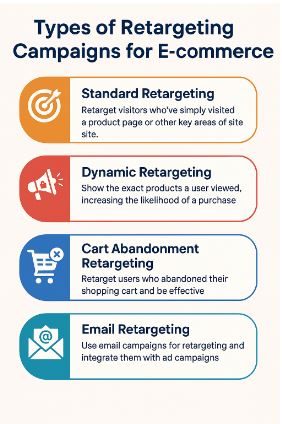
Retargeting campaigns are not one-size-fits-all. Different types of campaigns can be used to target visitors based on their behavior and actions on your website. By implementing the best retargeting strategies for e-commerce, you can tailor your approach to reach the right audience with the right message at the right time. Below are the most effective types of retargeting campaigns you should consider for your e-commerce business.
#1. Standard Retargeting
Standard retargeting is one of the simplest and most common types of retargeting campaigns. It targets users who have visited your website but didn’t take the desired action (such as completing a purchase). These visitors might have checked out a product page, browsed different categories, or spent time on other key pages.
For example, if a visitor checks out a product but leaves without purchasing, you can retarget them with ads displaying the same product or similar items, encouraging them to return to your store.
Keep your ad creatives simple, with clear calls to action (CTA) that direct users back to the exact product they viewed.
#2. Dynamic Retargeting
Dynamic retargeting takes personalization a step further by automatically showing users the exact products they viewed on your website. These highly personalized ads can feature specific product images, descriptions, and prices—directly reflecting the user’s previous browsing behavior.
Since the ads are so relevant to the user’s interests, dynamic retargeting tends to result in higher click-through and conversion rates compared to standard retargeting.
For example, if a user visited a product page for a pair of running shoes but didn’t purchase them, dynamic ads will display those same shoes, possibly with a discount or free shipping offer to encourage the user to complete their purchase.
Keep your dynamic retargeting ads up to date by syncing your product feed with your ad platform to ensure real-time inventory and price changes are reflected in the ads.
#3. Cart Abandonment Retargeting
One of the most effective forms of retargeting for e-commerce is cart abandonment retargeting. This strategy focuses on users who added products to their shopping cart but left the site before completing the checkout process.
Cart abandoners are already at the final stage of the purchasing process, meaning they have a high likelihood of converting if reminded.
You can offer incentives such as discounts, free shipping, or limited-time deals to encourage users to complete their purchase.
Cart abandonment retargeting typically offers a high ROI because you’re targeting users who’ve already shown intent to buy.
After a visitor abandons their cart, retargeting ads can remind them of their abandoned items. The ad can feature a message such as “Don’t miss out on your cart!” or a limited-time discount code to entice the user to return and finalize the purchase.
Personalize cart abandonment ads with the exact products left behind and consider offering a small incentive (like a discount) to make the purchase more attractive. This particular type of retargeting helped our client tremendously.
#4. Email Retargeting
Email retargeting involves using email marketing campaigns alongside your ad retargeting efforts. If a user has visited your site or interacted with your products but hasn’t made a purchase, an email reminder can help bring them back to your store.
Email retargeting allows you to directly engage users in their inbox, offering personalized offers, discounts, or updates on the products they viewed.
Email often has a higher open rate compared to other forms of marketing. When combined with retargeting ads, this can be a powerful strategy to drive conversions.
Since email retargeting leverages an existing email list, it’s one of the most cost-effective ways to re-engage potential customers.
Once a user has interacted with your store (whether through browsing or adding items to their cart), an automated email can be triggered to remind them of the product, offer a discount, or provide information to encourage a purchase.
Use segmentation to send personalized emails, such as offering specific discounts or featuring recommended products based on the user’s browsing history.
#5. Video Retargeting
Video retargeting is a powerful way to engage users who have interacted with your site but didn’t convert. By using engaging video ads, you can capture the user’s attention and encourage them to return to your site and make a purchase.
Retarget users with video ads that feature the product they previously viewed, or create video ads that highlight other products they may be interested in. Adding a CTA like “Shop Now” or “See More” encourages users to take action.
Ensure to keep your videos short, engaging, and relevant. Focus on showing the product in action, explaining its benefits, or offering a limited-time promotion to create urgency.
What Are the Best Practices for Retargeting Ads?
When implementing retargeting ads, applying best practices ensures your campaigns are as effective as possible while maintaining a positive experience for potential customers. Here are some key considerations:
#1. Ad Frequency and Timing
One of the biggest challenges in retargeting is finding the sweet spot in ad frequency. While it’s important to stay top of mind, bombarding your audience with too many ads can lead to ad fatigue, resulting in decreased effectiveness or even brand annoyance.
Aim to show retargeting ads 3-5 times per week. Overexposing your audience can result in ad burnout and cause users to ignore or even block your ads.
Pay attention to when users are most likely to engage with your ads. For example, running ads during evening hours or weekends may yield better results as people have more free time to shop.
If your audience interacts with your site frequently, consider showing them different ads over time to avoid repetitive content. This keeps the messaging fresh and engaging.
Proper frequency and timing ensure that your ads reach users at the right moments without overwhelming them. The result is a more effective strategy that maintains interest and keeps users engaged.
#2. Personalization in Retargeting Ads
Personalized retargeting ads have been shown to drive higher conversion rates compared to generic ads. Personalization can involve showcasing the exact products a user viewed, recommending similar items, or tailoring offers based on their browsing history.
Use dynamic retargeting ads that display items users viewed or added to their cart. You can also showcase similar products that they may find interesting.
Tailor your ad copy and visuals based on user behavior. For instance, if a user added a product to their cart but didn’t purchase, your ad could highlight a discount or an incentive to encourage them to finalize the transaction.
Use insights from your analytics tools to understand user preferences, browsing habits, and previous interactions to create highly relevant retargeting ads.
Personalized ads foster stronger emotional connections with your audience, making it more likely they will return and make a purchase.
#3. Clear and Strong Call to Action (CTA): Creating Urgency and Offering Incentives
A compelling CTA is the cornerstone of a successful retargeting ad. Your CTA should clearly tell users what you want them to do and provide an incentive for immediate action.
Use strong, action-oriented language like “Buy Now,” “Shop Today,” or “Limited Time Offer.”
Incorporate time-sensitive language such as “Hurry, sale ends soon” or “Only a few items left” to create urgency.
Offering a discount, free shipping, or a bundle deal can significantly increase the likelihood of conversion.
A well-crafted CTA encourages users to take immediate action, reducing hesitation and increasing the chances of closing the sale.
#4. Use of High-Quality Visuals
In a crowded online environment, high-quality visuals are crucial to catching the attention of potential customers. The images and videos you use in your retargeting ads should be visually appealing and relevant to the product being advertised.
Use clear, professional images that showcase your product from multiple angles. For example, if you’re selling clothing, include a photo of the item being worn by a model.
Video ads are a powerful tool for engaging users, showing products in action, and telling your brand story. Keep videos short, high-quality, and focused on the product’s key selling points.
Ensure your visuals align with your overall brand aesthetics and messaging to maintain consistency across all ads and channels.
High-quality visuals capture attention and create a positive impression of your brand, increasing the likelihood of users clicking on your ad and making a purchase.
#5. Mobile Optimization: Ensuring Ads are Ready for Mobile Shoppers
With more consumers shopping on mobile devices, it’s crucial to ensure your retargeting ads are mobile-optimized. This includes ensuring your ads look great on smaller screens, load quickly, and provide a smooth user experience.
Ensure your ads adapt seamlessly to mobile screens. This means using mobile-friendly images and formatting text for easy readability on smaller devices.
Speed is essential—users are more likely to abandon ads or websites that take too long to load. Make sure your landing pages are optimized for mobile.
Make sure your CTA buttons are large enough to click on mobile devices, improving the user experience and increasing the chances of a conversion.
Mobile optimization ensures that your ads reach users in the best possible format, improving engagement and conversions, especially as mobile commerce continues to rise.
Creative Strategies for Retargeting
In addition to implementing best practices, using creative strategies in your retargeting ads can further enhance their effectiveness and drive sales. Here are some creative tactics to incorporate into your retargeting campaigns:
#1. Upsell and Cross-Sell Strategies
Retargeting ads are an excellent opportunity to increase your average order value by encouraging customers to buy higher-value products (upselling) or complementary items (cross-selling).
i. Upselling: For example, if a user adds a basic phone case to their cart, retarget them with an ad offering a premium, more expensive phone case or a bundle deal with other accessories.
ii. Cross-Selling: Suggest items that complement the products users have already shown interest in. For instance, if a customer is looking at a jacket, suggest matching scarves or hats.
iii. Offer Discounts on Upsells or Cross-Sells: Providing a discount when purchasing the upsell or cross-sell item can incentivize the user to complete the purchase.
These strategies increase the value of each transaction, benefiting your business by driving higher revenue without additional customer acquisition costs.
#2. Special Offers and Discounts: Creating Temptation with Limited-Time Deals
One of the best ways to drive conversions through retargeting ads is by offering special deals, discounts, or promotions. Time-sensitive offers make users feel like they need to act quickly, increasing the likelihood of them completing a purchase.
i. Offer Discounts on Abandoned Carts: Offering a discount for cart abandonment ads can help encourage users to finish the purchase they nearly made.
ii. Limited-Time Promotions: Use countdown timers to show how long an offer will be available, creating a sense of urgency.
iii. Seasonal Offers: Capitalize on seasonal events or holidays (Black Friday, Christmas, etc.) by offering discounts and promotions tailored to the time of year.
Offering exclusive deals or discounts provides added value, enticing customers to take action while the offer is still available.
#3. Time-Sensitive Retargeting: Urging Immediate Action
A great way to motivate users to complete a purchase is to create urgency through time-sensitive retargeting. These ads can feature countdown clocks or messages like “Hurry, offer ends soon” or “Only a few items left.”
i. Countdown Timers: Implement countdown timers in your ads to display the exact time remaining for an offer.
ii. Scarcity Messaging: Highlight limited stock or availability to create urgency, such as “Only 3 left in stock!”
iii. Urgent CTAs: Use CTAs like “Buy Now” or “Shop Before It’s Gone” to push users to act fast.
Time-sensitive offers drive action by creating a sense of urgency, prompting users to complete their purchase before the opportunity is gone.
#4. Use of Testimonials and Social Proof
Incorporating user reviews, testimonials, and social proof in your retargeting ads is a powerful way to enhance trust and persuade hesitant customers to make a purchase.
i. Customer Reviews: Display positive reviews or ratings from happy customers to build confidence in the product.
ii. Social Proof: If possible, show how many other people have bought the product or how popular the item is with others.
iii. Influencer Endorsements: Leverage influencer testimonials or partnerships to add credibility and attract more attention to your products.
Social proof increases consumer trust and reduces the perceived risk of purchasing, which can be especially effective for users who are on the fence about buying.
By using these creative strategies for retargeting combined with best practices, you can elevate your e-commerce advertising efforts, resulting in more engaged customers, increased conversions, and higher revenue.
Conclusion
In conclusion, retargeting strategies for e-commerce are a powerful tool to increase conversions, engage potential customers, and boost sales. By focusing on personalized, timely, and visually engaging ads, you can successfully re-engage users who have shown interest in your products but haven’t completed a purchase. From leveraging major platforms like Facebook and Instagram to using advanced tactics like cart abandonment retargeting and dynamic ads, the possibilities to enhance your campaigns are vast.
Now that you have a clear understanding of the best retargeting strategies for e-commerce, it’s time to put them into action! Start by implementing one strategy in your next campaign. For instance, try dynamic retargeting or set up a cart abandonment retargeting flow to begin with. As you start seeing success, scale your efforts and experiment with different types of ads and platforms to further optimize your results.
If you’re looking to dive deeper into digital advertising, retargeting, or e-commerce strategies, check out these helpful resources:
- Facebook Ecommerce Ads Guide And Strategies For Beginners
- Drive Significant Online Growth with Google Ads for Ecommerce
- Free Course on Retargeting for E-commerce Marketers
By implementing these strategies and continuously optimizing your campaigns, you’re on your way to achieving higher engagement and conversions for your e-commerce business.



